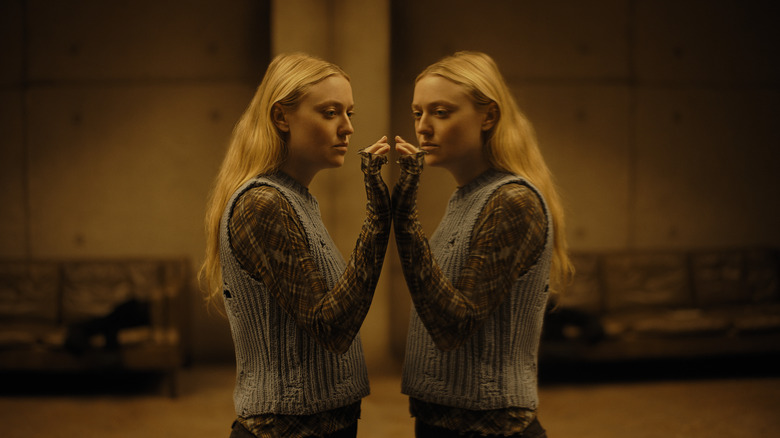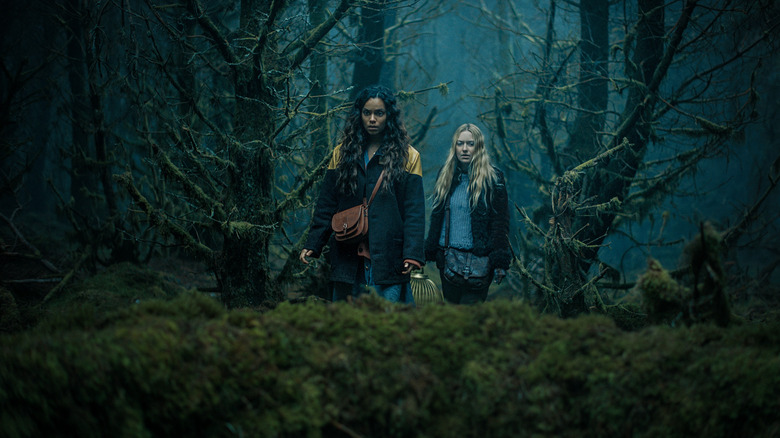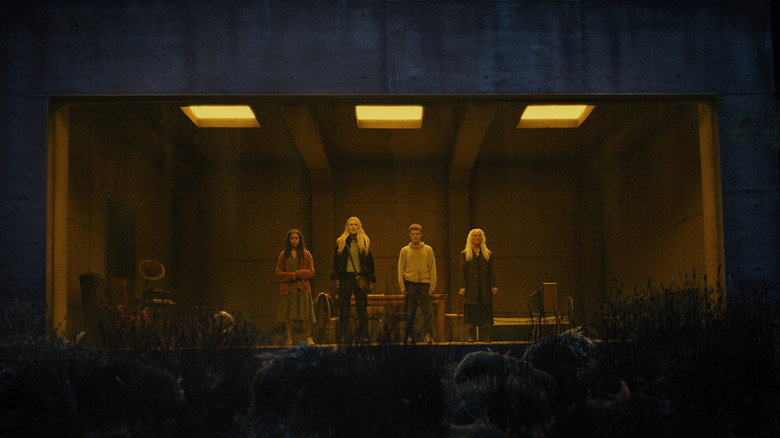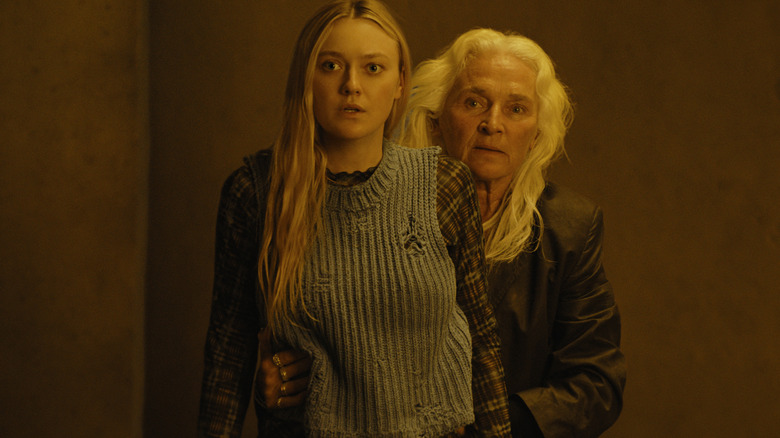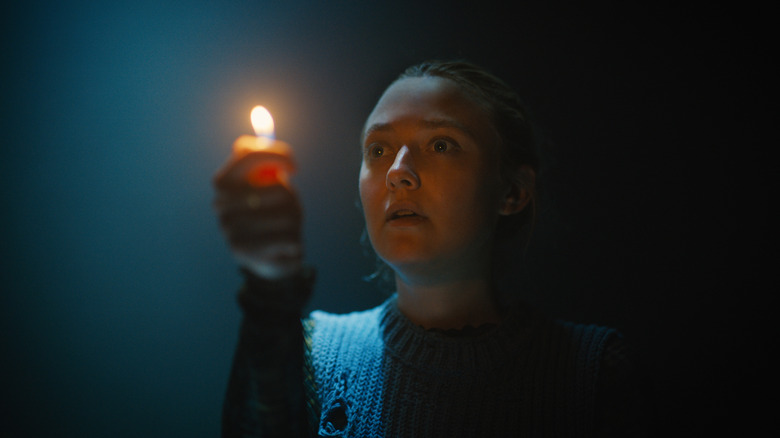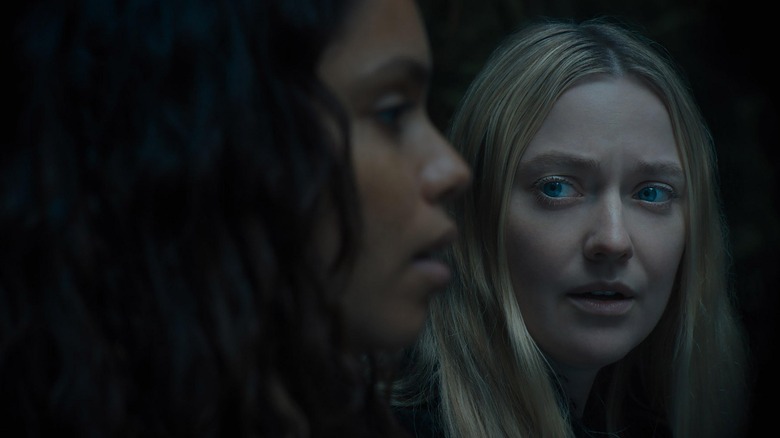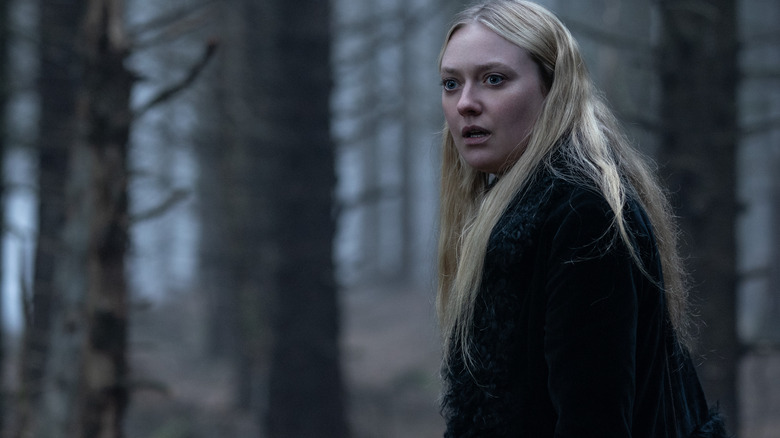The Watchers Ending Explained: Seeing Double
We may receive a commission on purchases made from links.
Warning: In case the headline didn't give it away, this article contains major spoilers for "The Watchers."
Stop me if you've heard this one before: A filmmaker with the last name Shyamalan released a horror movie about creepy (and possibly supernatural) threats in the middle of a secluded forest ... and, yes, there's a big plot twist hiding in plain sight. Reactions to "The Watchers" turned out to be rather divisive, as you can see from my rather mixed review for /Film prior to release in the summer of 2024, but the sense of atmosphere and tone certainly felt consistent with someone who received their film-school crash course under the tutelage of M. Night Shyamalan himself. Up-and-coming filmmaker Ishana Night Shyamalan served as a second-unit director on M. Night's 2021 film "Old" and as director on several episodes of his streaming series "Servant," but that's pretty much where the similarities between father and daughter end.
Ishana Night Shyamalan's debut feature "The Watchers" very much abides by its own rules entirely. It'd be far too reductive to try and put it in a box, much like the room-sized one (known as "the Coop") that serves as the main setting of this one-location thriller. This isn't her version of "The Village," nor is it her attempt to live up to the sky-high expectations set by "The Sixth Sense." Instead, the Dakota Fanning-led film feels like a young filmmaker taking all the skills she had the privilege of picking up over the years and applying it on the biggest possible canvas. The final result is an unwieldy, strained, but undeniably confident breakthrough that comes loaded with dense amounts of folklore, mythology, and, of course, a twist or two.
Although not necessarily the most confusing or convoluted addition to the Shyamalan oeuvre (both of them), the final sequence of "The Watchers" and everything leading up to it undoubtedly leaves viewers buzzing — for better and for worse.
Getting lost in the woods with a different Shyamalan
It doesn't take very long for "The Watchers" to reveal perhaps its biggest source of inspiration — fairytales.
Based on the novel of the same name by author A. M. Shine, Ishana Night Shyamalan's adaptation initially follows all the tropes of many a children's fable: a dark and mysterious forest hiding sinister secrets, a lead character harboring a traumatic past, and even an animal sidekick in her parrot Darwin, who's only able to comically repeat the phrase, "Don't die now." These fantasy trappings extend to the chilling cold open following an unnamed character (played by Alistair Brammer) running for his life in the woods. Desperate and in a frenzy to escape some unseen foe, we can only watch helplessly as he succumbs to his panic and becomes the first victim of the film, thus setting the stakes for everything to come.
From there, Shyamalan wastes little time establishing Dakota Fanning's wayward, loner, but steely Mina as someone who's destined (or doomed) to find herself in that very same predicament. While working at a pet store, her boss tasks her with transporting a prized parrot across Western Ireland to an awaiting zoo. The little we find out about her in the early going reveals a figure who wears all sorts of different masks in her daily life. She'd rather lie about her name and background to sleep with attractive Irish guys at a local bar, as opposed to letting anyone get close and find out the truth about the decade-old trauma that she refuses to process. We catch glimpses of this childhood moment in sporadic flashbacks, focusing on her mother (Siobhan Hewlett) and twin sister Lucy (sibling actors Hannah Dargan and Emily Dargan portray young Mina and Lucy, respectively) as Mina becomes indirectly responsible for a deadly accident that permanently scars her sister and claims the life of her mother.
This, as we learn, goes on to play a significant role in Mina's overall arc.
Who watches the Watchers?
To nobody's surprise, Mina's grief and pain comes back to haunt her in a much more literal fashion as "The Watchers" finally drops all pretenses and doubles down on supernatural mysteries. After breaking down in a remote forest road, Mina makes a short trek on foot to look for help ... when, suddenly, she can't find her car or the road back to civilization. Hunted by otherworldly noises and a murder of crows, our protagonist finally catches sight of a lone figure (Olwen Fouéré as Madeline) urgently beckoning her to run for the safety of a random, out-of-place bunker in the middle of nowhere.
Here, we learn the basics of the premise. Every night, mysterious "Watchers" surround the Coop trapping Mina with Madeline, the jumpy Daniel (Oliver Finnegan), and distracted Ciara (Georgina Campbell) and simply ... watch them. The off-putting scenario puts these four characters on the level of performance art, forced to put on a show of their daily minutiae for an audience that they can neither see nor understand — not unlike what actors themselves do when performing in a stage play, television series, or a big-budget horror movie. The parallels draw even deeper once we're shown Mina's only source of entertainment: a rickety old reality TV show from decades past that's blatantly riffing on current media, like the trashy joys of "Love Island."
The implication, of course, turns the question back on us viewers. Are the vaguely menacing Watchers meant to be a stand in for us viewers, callously demanding entertainment and catharsis from our media while dehumanizing the very people who provide us with the art in the first place? Are we all victims of the same capitalistic pursuit, prizing profit above all else? Things get clearer — and weirder — from there.
The mythology and lore of The Watchers
As much as "The Watchers" plays with ambiguity and mystery for much of its runtime, the thread begins unraveling once our characters begin to figure out the truth behind their plight.
After alluding to a secretive individual known only as "The Professor," Mina's flagrant breaking of the rules (which stipulate remaining in the box after sundown, staying away from the burrows that the Watchers use to climb to the surface, and never turning one's back on the one-way mirror separating them from the outside world) sets them all on a path towards both destruction and revelation. Having angered the Watchers to the point of a violent attempt to break into the Coop, the characters stumble upon a very "Lost"-like hatch built into the floor that leads them to an underground bunker. Here, a series of conveniently-recorded videos by Professor Kilmartin (John Lynch), an actual university professor who became obsessed with a hidden slice of long-forgotten history, reveals that he had studied the Watchers — even capturing one underneath the Coop — and purposefully built this experiment in the woods to learn more about them, ultimately resorting to unethical measures to get the results he needed.
As it turns out, the Watchers are actually what we'd refer to as changelings or faeries in our own cultural mythologies. A long-ago war pitted humanity against these beings and resulted in their exile underground. Having spent centuries trying to break free, the Watchers have studied the humans that wandered into their last remaining stronghold in the Irish woods and slowly perfected the art of mimicking their appearances. Our characters' white-knuckle escape from their imprisonment (minus Daniel, who is brutally killed along the way) and their return to civilization feels like the natural end of the story ... but Shyamalan keeps one more twist up her sleeve.
The Watchers' biggest twist
Conventional wisdom tends to claim that plot twists should never be telegraphed or set up in any obvious way prior to the big reveal, but that couldn't be further from the truth. If executed well, twists ought to feel both surprising and inevitable at the same time. Clever writers are able to bury hints and teases of an overall idea in the early going, allowing for audiences to intuitively pick up on those breadcrumbs throughout the natural progression of the story (and, ideally, without even consciously realizing it) so that the twist can hit with the full weight of its import. It's a magic trick, essentially, and one that "The Watchers" nearly manages to pull off.
In a reveal that perhaps undercuts the intelligence of the typically-resourceful Mina, we find out that the person we thought was Madeline was actually a Watcher in disguise all along. Upon escaping from the forest, Mina follows the clues to the Professor's university and finds his office where she learns the truth about Madeline's true identity: the late wife of the Professor, whose identity has now been stolen by the Watcher. This comes as little surprise, unfortunately, seeing how we learn even less about the Madeline imposter than any of the other supporting characters and this lines up perfectly with her one defining character trait: a tendency to simply serve as exposition for the surprisingly dense lore that makes up the world-building of this film.
Although it explains far too much, the final battle between Mina and "Madeline" takes a more philosophical approach, offering up no easy answers to this centuries-old conflict. It ends on an uneasy note, with "Madeline" loosed upon the world. To what end? Not even the Watchers themselves can say.
Why did Madeline spare Mina in the ending of The Watchers?
There's a good reason why, prior to release, the marketing campaign for "The Watchers" kept the entirety of the final act under tight wraps. This extended coda is when the chickens come home to roost (so to speak) and all the biggest revelations finally end up addressed by our main characters. In what could be considered another twist, Mina returns from her visit to the Professor's office and slowly realizes that the fellow survivor she thought was Ciara has actually been the shapeshifter "Madeline" in disguise, now walking freely among unsuspecting humans as one of them. After subduing the real Ciara and announcing herself as Ainriochtán (meaning "The Strange One," "The Daywalker," or "The Deformity"), the Watcher turns her malevolent gaze upon Mina herself. She knows too much and can't be trusted to keep the secret of who the Watchers actually are, she reasons, and so Mina is doomed to become the shapeshifter's next victim.
Taking on Mina's own form and threatening her life, the Watcher offers to "take away all your suffering" through her death ... but ultimately chooses to spare her life. Using what she learned at the university to her advantage, Mina explains one final mystery hanging over the head of Ainriochtán: that both humanity and the Watchers once lived in harmony together, and that their close proximity to one another naturally led to some falling in love and having children known as halflings. Ainriochtán is, of course, a result of a Watcher and human coupling, which reveals why she's able to walk around in broad daylight far away from the forest that held them captive for so many eons. Her mixed heritage also helps us make sense of "Madeline's" awfully emotional actions to this point, re-contextualizing this strange behavior as a representation of her human half at war with her changeling side.
What saves Mina's life is her impassioned speech, correctly intuiting that "Madeline" has been able to experience the full spectrum of human emotions during her time undercover and fully relating to the Watcher's insecurities of feeling like a monster.
The movie ending vs. the book's ending
"The Watchers" might feel like the type of story that someone in the Shyamalan family might have conjured out of thin air but, as mentioned earlier, it's actually based on writer A. M. Shine's novel of the same name. Although largely faithful to the tone and spirit of the novel, Ishana Night Shyamalan takes her fair share of liberties with the material (as documented by Screen Rant) — an understandable and inevitable result of translating the story from one medium to another. Fans of the book and the movie may quibble over which version feels like the most satisfying one, but there's certainly no reason to pit one against the other. Instead, those on both sides of the divide can gain insight from understanding the changes made by the movie.
While the broad strokes of the plot unfold the same way, the biggest departure in Ishana Night Shyamalan's retelling of "The Watchers" has to do with the way the story comes to a close. As explained above, the conflict between Mina and Madeline/Ainriochtán reaches a boiling point and turns into an ugly, violent, and extended affair as each character struggles to understand the other. Only Mina's startling revelation about her foe's halfling origins while literally being choked to death manages to motivate Ainriochtán's change of heart. In the novel, however, Mina returns from her journey to the Professor's office and goes over her discovery with the real Ciara, who hasn't been impersonated. Then, when "Madeline" arrives on the scene, Mina simply talks to her and calmly reasons with her that their two kinds can coexist once again without resorting to killing.
Both the book and the movie, however, leave plenty of room for a potential sequel.
Will there be a sequel to The Watchers?
Have we seen the last of Mina and the Watcher hiding in plain sight as Madeline? Well, yes and no. The novel, which was originally published in 2021, already spawned a sequel titled "Stay In The Light" that hit bookshelves in October of 2024. In another slight difference from the movie, the ending of the first book actually implies that Mina remains in danger of the other Watchers out in the world. When the sequel picks up, Mina has struggled to leave her traumatic experience behind her and continues to live in fear of future encounters with the supernatural beings. When she crosses paths with a suspicious-looking stranger and various people in the area begin disappearing, she realizes that the Watchers have returned to her doorstep. Unable to convince anyone of her fears, Mina prepares to face off with the monsters once again.
Although the movie ends on an altogether more hopeful note, with Mina reuniting with her sister and quietly remarking that she believes "Madeline" is still out there watching over her, a sequel could easily adapt this premise for another movie. In fact, the director previously told The Movie Blog that "[...] the end of the film is meant to establish a larger world" and remained coy about whether she'd want to helm a sequel film or not. Unfortunately, "The Watchers" debuted to a disappointing opening weekend at the box office and there has been no word on whether Warner Bros. is willing to open up their checkbook for another kick at the can. Combined with the tepid critical reaction (the film currently sits at an unsightly 32% on Rotten Tomatoes), it would appear that the chances of a sequel are awfully low.
Even if a follow-up film isn't in the cards, the film undoubtedly has much to offer for horror fans. As a proof of concept for a burgeoning filmmaker who clearly has the chops, viewers may look back at this as a stepping stone to greater things to come. Ishana Night Shyamalan's "The Watchers" can currently be seen streaming on Max.
